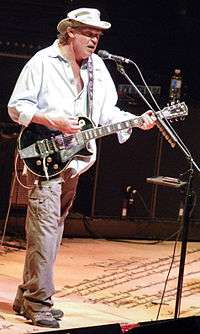Old Black

Old Black is the name given to the main electric guitar used by rock musician Neil Young. Most of Young's electric guitar parts were recorded on "Old Black," though some were played on Gretsch White Falcons or on an orange Gretsch Chet Atkins. Young acquired Old Black in 1969 through a trade with one-time Buffalo Springfield collaborator Jim Messina,[1] who received one of Young's orange Gretsch guitars (Gretsch 6120 Chet Atkins) in exchange.
Appearance and customization
Old Black is a 1953 Gibson Les Paul Goldtop, painted black[1] and customized considerably. After the guitar had been left at a guitar repair store, the original P-90 bridge pickup was replaced with a Gretsch Dynasonic single-coil pickup. Eventually, a mini humbucker pickup from a Gibson Firebird guitar replaced the Dynasonic. The neck pickup has always been the original P-90 pickup, but it is now covered by a hand fitted aluminum P-90 cover, replacing the original white plastic cover. The guitar was roughly resprayed to jet black, and received a new Tune-o-matic bridge (not available when the guitar was produced) and a B-7 model Bigsby vibrato tailpiece. It would presumably also have had a white plastic pickguard at some point, as was standard on 1953 Goldtops. Old Black is notable for its metal hardware, including aluminum backing plates. The pick guard is chrome-on-brass/bronze. The tuners have been replaced with Schaller M-6 tuning keys, and the rest of the hardware is mostly nickel-plated. The headstock displays a partially painted-over mother-of-pearl inlay, sometimes referred to as a "wheat stack", rather than the typical silk screened "Les Paul Model" logo, along with single-ply binding around the headstock, although the binding has now fallen off.
Condition
Old Black has seen considerable wear and tear, with most of the black paint removed from the mahogany neck. A white maple type binding extends down the back of the guitar neck but it has been pulled off from the body, resulting in the removal of a jagged strip of body wood down the back. An additional round aluminum access plate is present on the back of Old Black, approximately underneath the bridge, the purpose of which is unknown, but possibly for the mini toggle switch before the Bigsby vibrato arm was fitted.
Other modifications
Old Black has also been customized with a small toggle switch in the front of the guitar, between original pickup volume and tone adjustment knobs. This switch is not a coil tap, as would commonly be assumed, but rather is a switch that allows Young to bypass the potentiometers and capacitors and send his sound directly to his amplifier (a late-1950s Fender Deluxe).
Additional modifications from the original factory condition include the addition of a Firebird pickup installed in the bridge position (not just a covered P-90 as once thought), a metal truss rod plate, and a screw-fender washer combination replacing the standard strap knobs. Old Black has rarely been seen without Neil Young's famous peace symbol and dove guitar strap, which has also seen modifications over the years—most notably, its attachment to a Levy's wide guitar strap.
Usage
Most of Young's electric guitar parts have been recorded on Old Black (with the notable exception of The Ditch Trilogy) though some were played on Gretsch White Falcons and Nashvilles, as well as Fender Telecasters, a Gibson Flying V and other, newer Goldtops.
See also
Notes
- 1 2 "6 Superstar Guitars With Superstar Nicknames". www.gibson.com.
References
- "6 Superstar Guitars with Superstar Names". Gibson Guitars. 2009-05-14. Retrieved 2014-04-25.
- "Neil Young's Sound". Thrasher's Wheat - A Neil Young Archives. June 2003. Retrieved 2008-11-10.
- McDonough, Jimmy (2002). Shakey: Neil Young's biography. New York: Random House. ISBN 978-0-679-42772-8. OCLC 47844513.
- Heatley, Michael (1997). Neil Young: in his own words. London, New York: Omnibus Press. ISBN 978-0-7119-6161-6. OCLC 38727767.
- Bienstock, Richard (June 2011). "Ragged Glory". Guitar Legends (118): 30–33.
External links
- An interview with Young's guitar tech, Larry Cragg from thrasherswheat.org
- Neil Young's Sound from thrasherswheat.org, with a picture of Old Black
- Guitar World - Neil Young: Ragged Glory